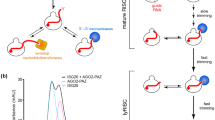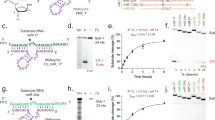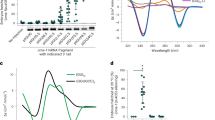Abstract
In RNA interference (RNAi), guide RNAs direct RNA-induced silencing complexes (RISC) to their mRNA targets, thus enabling the cleavage that leads to gene silencing. We describe a strong inverse correlation between the degree of guide-RNA secondary structure formation and gene silencing by small interfering (si)RNA. Unstructured guide strands mediate the strongest silencing whereas structures with base-paired ends are inactive. Thus, the availability of terminal nucleotides within guide structures determines the strength of silencing. A to G and C to U base exchanges, which involve wobble base-pairing with the target but preserve complementarity, turned inactive into active guide structures, thereby expanding the space of functional siRNAs. Previously observed base degenerations among mature micro (mi)RNAs together with the data presented here suggest a crucial role of the guide-RNA structures in miRNA action. The analysis of the effect of the secondary structures of guide-RNA sequences on RNAi efficiency provides a basis for better understanding RNA silencing pathways and improving the design of siRNAs.
This is a preview of subscription content, access via your institution
Access options
Subscribe to this journal
Receive 12 print issues and online access
$209.00 per year
only $17.42 per issue
Buy this article
- Purchase on Springer Link
- Instant access to full article PDF
Prices may be subject to local taxes which are calculated during checkout




Similar content being viewed by others
Accession codes
References
Elbashir, S.M. et al. Duplexes of 21-nucleotide RNAs mediate RNA interference in cultured mammalian cells. Nature 411, 494–498 (2001).
Lagos-Quintana, M., Rauhut, R., Lendeckel, W. & Tuschl, T. Identification of novel genes coding for small expressed RNAs. Science 294, 853–858 (2001).
Lau, N.C., Lim, L.P., Weinstein, E.G. & Bartel, D.P. An abundant class of tiny RNAs with probable regulatory roles in Caenorhabditis elegans. Science 294, 858–862 (2001).
Lee, R.C. & Ambros, V. An extensive class of small RNAs in Caenorhabditis elegans. Science 294, 862–864 (2001).
Meister, G. et al. Human Argonaute2 mediates RNA cleavage targeted by miRNAs and siRNAs. Mol. Cell 15, 185–197 (2004).
Fagard, M., Boutet, S., Morel, J.B., Bellini, C. & Vaucheret, H. AGO1, QDE-2, and RDE-1 are related proteins required for post-transcriptional gene silencing in plants, quelling in fungi, and RNA interference in animals. Proc. Natl. Acad. Sci. USA 97, 11650–11654 (2000).
Hammond, S.M., Boettcher, B., Caudy, A.A., Kobayashi, R. & Hannon, G.J. Argonaute2, a link between genetic and biochemical analyses of RNAi. Science 293, 1146–1150 (2001).
Tomari, Y., Matranga, C., Haley, B., Martinez, N. & Zamore, P.D. A protein sensor for siRNA asymmetry. Science 306, 1377–1380 (2004).
Khvorova, A., Reynolds, A. & Jayasena, S.D. Functional siRNAs and miRNAs exhibit strand bias. Cell 115, 209–216 (2003).
Schwarz, D.S. et al. Asymmetry in the assembly of the RNAi enzyme complex. Cell 115, 199–208 (2003).
Reynolds, A. et al. Rational siRNA design for RNA interference. Nat. Biotechnol. 22, 326–330 (2004).
Ui-Tei, K. et al. Guidelines for the selection of highly effective siRNA sequences for mammalian and chick RNA interference. Nucleic Acids Res. 32, 936–948 (2004).
Kretschmer-Kazemi Far, R. & Sczakiel, G. The activity of siRNA in mammalian cells is related to structural target accessibility: a comparison with antisense oligonucleotides. Nucleic Acids Res. 31, 4417–4424 (2003).
Bohula, E.A. et al. The efficacy of small interfering RNAs targeted to the type 1 insulin-like growth factor receptor (IGF1R) is influenced by secondary structure in the IGF1R transcript. J. Biol. Chem. 278, 15991–15997 (2003).
Vickers, T.A. Efficient reduction of target RNAs by small interfering RNA and RNase H-dependent antisense agents. A comparative analysis. J. Biol. Chem. 278, 7108–7118 (2003).
Heale, B.S.E., Soifer, H.S., Bowers, C. & Rossi, J.J. SiRNA target site secondary structure predictions using local stable substructures. Nucleic Acids Res. 33, e30 (2005).
Schubert, S., Grunweller, A., Erdmann., V.A. & Kurreck, J. Local RNA target structure influences siRNA efficacy: systematic analysis of intentionally designed binding regions. J. Mol. Biol. 348, 883–893 (2005).
Overhoff, M. et al. Local RNA target structure influences siRNA efficacy: a systematic global analysis. J. Mol. Biol. 348, 871–881 (2005).
Zuker, M. & Stiegler, P. Optimal computer folding of large RNA sequences using thermodynamics and auxiliary information. Nucleic Acids Res. 9, 133–148 (1981).
McCaskill, J.S. The equilibrium partition function and base pair binding probabilities for RNA secondary structure. Biopolymers 29, 1105–1119 (1990).
Griffiths-Jones, S. The microRNA registry. Nucleic Acids Res. 32 Database issue, D109–111 (2004).
Doench, J.G. & Sharp, P.A. Specificity of microRNA target selection in translational repression. Genes Dev. 18, 504–511 (2004).
Haley, B. & Zamore, P. Kinetic analysis of the RNAi enzyme complex. Nat. Struct. Mol. Biol. 11, 599–606 (2004).
Schwarz, D.S., Hutvágner, G., Haley, B. & Zamore, P.D. Evidence that siRNAs function as guides, not primers, in the Drosophila and human RNAi pathways. Mol. Cell 10, 537–548 (2002).
Ma, J-B. et al. Structural basis for 5′-end-specific recognition of guide RNA by the A. fulgidus Piwi protein. Nature 434, 666–670 (2005).
Rivas, F.V. et al. Purified Argonaute2 and an siRNA form recombinant human RISC. Nat. Struct. Mol. Biol. 12, 340–349 (2005).
Patzel, V. & Sczakiel, G. Theoretical design of antisense RNA structures substantially improves annealing kinetics and efficacy in human cells. Nat. Biotechnol. 16, 64–68 (1998).
Mathews, D.H., Burkard, M.E., Freier, S.M., Wyatt, J.R. & Turner, D.H. Predicting oligonucleotide affinity to nucleic acid targets. RNA 5, 1458–1469 (1999).
Hofacker, I.L. Vienna RNA secondary structure server. Nucleic Acids Res. 31, 3429–3431 (2003).
Acknowledgements
This work was supported by grants from the German Federal Ministry of Education and Research (BMBF) and the Senate of the city of Berlin 0313068C, 0313066F, 0313066C-11, SenBB3066C-11 (RNA Network) cosponsored by Chiron Corp. and amaxa biosystems and 01 GS 0413 (NGFN). S.R. was supported by a grant from the Boehringer Ingelheim Fonds. We thank T. Ritter for providing plasmid pBabe-Jagged-1. C.K. was partly affiliated with the STZ Nucleic Acids Design (http://www.stz-nad.com).
Author information
Authors and Affiliations
Corresponding author
Ethics declarations
Competing interests
The authors C.K. and V.P. are avocationally affiliated to the Steinbeis Transfer Center for Nucleic Acids Design (STZ-NAD; http://www.stz-nad.com/). The STZ-NAD is an institution for technology transfer, which offers services around nucleic acids design. As full-time employess of the Max-Planck-Society, which is an institution of academic research, the authors ensure that declared interests did not influence the objectivity, integrity or perceived value of this article.
Supplementary information
Supplementary Fig. 1
Structures of guide-RNA are correlated with RNAi. (PDF 33 kb)
Supplementary Fig. 2
RNase T1 probing of as-siRNA structures 4-7, 0-0, and 2-9. (PDF 45 kb)
Supplementary Fig. 3
Predicted mfe structures and accessibility profiles of local jagged-1 mRNA targets. (PDF 48 kb)
Supplementary Fig. 4
Classifying guide-RNA secondary structures. (PDF 55 kb)
Supplementary Fig. 5
Model describing the determination of RNA silencing by RNA secondary structures. (PDF 270 kb)
Supplementary Data
Target structure accessibility and RNAi. (PDF 67 kb)
Supplementary Discussion
A, GU-rich guide-RNA generated by base exchanges. B, Guide-RNA structures and siRNA duplex formation. C, Uracil versus Thymin in guide-siRNA 3’ overhangs. (PDF 60 kb)
Supplementary Note
RNA secondary structure prediction: mfe vs. partition structures. (PDF 33 kb)
Rights and permissions
About this article
Cite this article
Patzel, V., Rutz, S., Dietrich, I. et al. Design of siRNAs producing unstructured guide-RNAs results in improved RNA interference efficiency. Nat Biotechnol 23, 1440–1444 (2005). https://doi.org/10.1038/nbt1151
Received:
Accepted:
Published:
Issue Date:
DOI: https://doi.org/10.1038/nbt1151
This article is cited by
-
MicroRNA: A Novel Micro-machineries to Target Crop Plants for Tolerance to Temperature Stress
Plant Molecular Biology Reporter (2024)
-
The mutual regulatory loop between TPTEP1 and miR-1303 in leukemogenesis of acute myeloid leukemia
Cancer Cell International (2021)
-
In silico prediction of short hairpin RNA and in vitro silencing of activin receptor type IIB in chicken embryo fibroblasts by RNA interference
Molecular Biology Reports (2019)
-
Nuclear receptor nhr-48 is required for pathogenicity of the second stage (J2) of the plant parasite Meloidogyne incognita
Scientific Reports (2016)
-
Validation of RNAi Silencing Efficiency Using Gene Array Data shows 18.5% Failure Rate across 429 Independent Experiments
Molecular Therapy - Nucleic Acids (2016)



